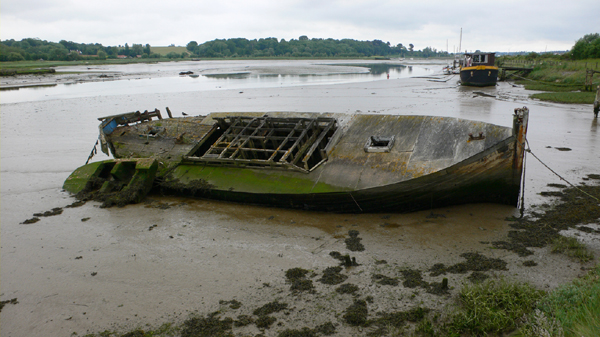When does a boat cease to be a boat? Prolegomena to a future photo-post
Mon. June 11, 2007Categories: Abstract Dynamics
Rotting boats in Woodbridge, yesterday. Photograph by Jon Wozencroft.
- The ship wherein Theseus and the youth of Athens returned had thirty oars, and was preserved by the Athenians down even to the time of Demetrius Phalereus, for they took away the old planks as they decayed, putting in new and stronger timber in their place, insomuch that this ship became a standing example among the philosophers, for the logical question of things that grow; one side holding that the ship remained the same, and the other contending that it was not the same.
The conundrum Plutarch described was already an old one when he wrote it down, and it has continued to haunt philosophy to this day. Can a ship be said to be the same ship if it has been completely rebuilt, so that not one of its original planks remain; and if it can be said to be the same, what is it that guarantees its identity?
In the twentieth century, Otto Neurath used the image of the ship rebuilt at sea for a quite different purpose. ‘We are like sailors who must rebuild the ship on the open sea, never able to dismantle it in dry-dock and to reconstruct it there out of the best materials,’ he wrote. Neurath’s intention with the metaphor, which became one of the most well-travelled images in twentieth century philosophy, was to debunk any straightforward appeal to experience – philosophers must work in an already-existing context (of language and concepts), which they cannot simply step outside. (No doubt Neurath was thinking of Kant’s ‘broad and stormy ocean, the true seat of illusion, where many a fog bank and rapidly melting iceberg pretend to be new lands and, ceaselessly deceiving with empty hopes the voyager looking around for new discoveries, entwine him in adventures from which he can never escape and yet also never bring to an end.’) Neurath’s coherentism is, I think, one version of the now widely disseminated mode of philosophy Graham Harman, after Hubert Dreyfus calls ‘deflationary realism’. (‘According to deflationary realism, the inseparability of reality and context means that there is no way of talking about things in themselves apart from human practices.’ Tool-Being, 122) In absolutely rejecting the ‘quarantining [of] the cosmos within a network of human significance’, in its pursuit of the ‘subterranean power of things’, in its positing of objects as endlessly opaque mysteries, Graham’s philosophy returns us to the ancient questions posed by the riddle of Theseus’ ship. What is an object, if its identity cannot be defined either by reference to its physical properties, or to any properties whatsoever?
The same question is posed in the work of Reza Negarestani but differently. The enigma Reza’s philosophy confronts, one familiar to Medieval Scholastic philosophy, is: how far can an object rot before it ceases to be the same object? When does a change in condition become a change in kind? The small town in which I live, Woodbridge in Suffolk, was founded on the craft of boat-building, and boats remain central to the place. Take the short walk from the town centre to the River Deben and you pass a number of boatyards. Walk along the river and you see many houseboats and pleasure craft moored. But when the boats fall into disrepair, they are not removed – presumably because that would be an expensive and cumbersome process – but are simply left where they stand, to rot on the riverbed, becoming a temporary resting place for birds and other scavengers. The boat-carcasses pictured above, though warped and dilapidated, are still, recognizably, boats. But as you walk alongside the river you see stumps, wood-skeletons, and slimy, huddled heaps: putrefying corpses of boats which are at the very limit of boathood – a picturesque exemplification of the problem that is at the heart of Reza’s philosophy. It would be good, one day, to have a photographic record of the various different stages of rotting-boat at Woodbridge.

Photograph by Jon Wozencroft